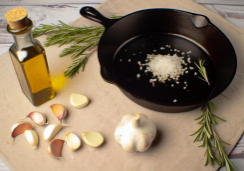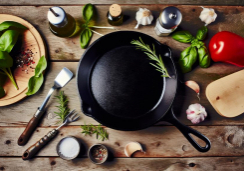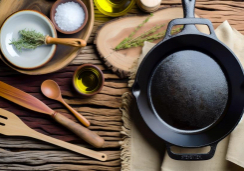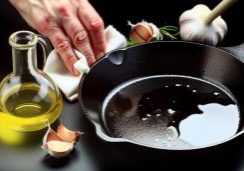Perfect Cast Iron Skillet Seasoning: Step-by-Step Guide
Just as a master painter primes their canvas before creating a masterpiece, you must properly season your cast iron skillet to lay the foundation for countless culinary creations.
You've likely heard that a well-seasoned skillet becomes the quintessential kitchen tool, effortlessly releasing pancakes, crisping bacon, and searing steaks to perfection. But it's not just about the first seasoning; maintaining the slick, non-stick surface demands regular care.
In this guide, you'll learn the art of seasoning your skillet step-by-step, from the initial wash to the final bake. You'll also discover how to preserve this labor of love, ensuring your skillet doesn't just perform well on its first outing, but continues to excel meal after meal.
So, if you're ready to transform your cast iron skillet from a mere piece of cookware to a treasured kitchen ally, prepare to equip yourself with the knowledge that will make all the difference.
Understanding Cast Iron Seasoning
To keep your cast iron skillet in top-notch condition, it's essential to understand that seasoning isn't just any layer, but a durable coating of polymerized oil that guards against rust and creates a non-stick surface. This cast iron seasoning forms through a process called polymerization, where the layer of oil baked onto the skillet's surface transforms into a hard, protective layer.
When you season a cast iron, you're essentially driving oil past its smoke point, causing it to break down and bond with the iron, creating a resilient surface. For this seasoning process to be effective, you must use cooking oil with a high smoke point. Vegetable oil, canola oil, or flaxseed oil are prime candidates for their ability to withstand the high heat required for seasoning.
You'll need to apply a thin layer of oil to the pan; a thick coat won't polymerize properly and could turn sticky. After each use, a quick rub with oil helps to maintain and even build up the seasoning, ensuring your cast iron skillet remains a reliable tool in your culinary arsenal.
Regular use and proper maintenance will keep the seasoning intact and improve its performance over time.
Initial Cleaning Process
Understanding that a proper seasoning is crucial for your cast iron skillet's performance, let's focus on the initial cleaning process that prepares it for this crucial step. If you've just brought home a new cast iron skillet, the initial cleaning process is your first step towards a well-seasoned kitchen staple.
Begin by washing your skillet with warm, soapy water. Yes, it's okay to use soap this time—the goal is to remove any factory residues or protective coating that may be on your new skillet. Use a stiff brush or non-metal scouring pads to scrub the skillet thoroughly, ensuring that you remove rust or any other debris that could interfere with the seasoning process.
Once you've scoured the skillet, rinse it well to get rid of all the soapy water. Now, it's time to dry it thoroughly. Any moisture left on the skillet can lead to rust, which would be counterproductive. After drying it with a towel, you might even want to place the skillet on a heated stove to evaporate any remaining water.
Now, your cast iron skillet is prepped and ready for the actual seasoning cast iron process. Remember, these initial steps are essential for building up that non-stick, rust-resistant surface you're aiming for.
Applying the Oil Evenly
After your cast iron skillet is clean and dry, it's essential to apply a thin, even layer of oil across the entire surface, ensuring the oil reaches the cookware's exterior, bottom, sides, and handle. For this task, vegetable shortening or a high-smoke-point oil works well.
Begin by dabbing a small amount onto a paper towel or a lint-free cloth.
Next, use the cloth to rub the oil into the cast iron pan, covering every inch of the cooking surface. Your goal isn't to leave the skillet dripping with oil but to apply a light coat that's barely visible. Pay special attention to the areas that come into contact with food most frequently, as these spots require a robust layer of seasoning for optimal non-stick performance.
As you apply the oil, make sure to buff it evenly across the surface. This process ensures that no excess oil builds up in pools, which could lead to sticky spots after the seasoning is baked on.
After you've achieved an even layer, remove any remaining oil residue with a clean paper towel. You're aiming for a surface that looks polished, without any oil droplets in sight.
Baking the Seasoning In
Once you've coated your cast iron skillet with a thin layer of oil, preheat your oven to 400°F and place the cookware upside down on the middle rack to bake the seasoning into the surface. This step is crucial in seasoning a cast-iron skillet as it initiates a process called polymerization. When exposed to high heat, the oil transforms into a tough, protective layer of carbonized coating that not only gives your cast iron cookware its non-stick qualities but also protects it from rust and wear.
Before sliding the skillet into the oven, make sure to place a baking sheet or aluminum foil on the bottom rack to catch any excess oil that drips off. You don't want to smoke up your kitchen or create a mess. Allow the skillet to bake undisturbed for about an hour. This duration lets the oil baked onto the surface form a solid bond, ensuring a durable finish.
After the time is up, turn off the oven and let the hot pan cool down completely inside the oven. Rushing this step might lead to a less effective seasoning, so patience is key. Once cooled, you'll have a beautifully seasoned skillet, ready for countless cooking adventures.
Can I Use Different Oils for Cast Iron Skillet Seasoning?
Yes, you can use different oils for cast iron skillet seasoning. Popular options include vegetable oil, flaxseed oil, and canola oil. Each oil has its own smoking point and unique properties, but all can be used to properly season a cast iron skillet.
Maintaining Your Seasoned Skillet
To ensure your cast iron skillet retains its non-stick surface and remains rust-free, it's essential to regularly maintain the seasoning. This can be done by cooking with oil and gently rubbing oil into the pan after each use. As you use your cast iron, each time you cook contributes to building up the layers of seasoning that make your skillet virtually non-stick. This layer is a blend of cast iron and carbon, created through the repeated application of oil and heat.
When you need to clean your skillet, do so with minimal soap and avoid scouring pads that can strip away the good layer of seasoning you've worked hard to establish. After washing, dry your skillet upside down in a warm oven or on the stove to ensure no moisture is left to rust the iron. Then, reapply a thin layer of oil after every use to protect the seasoning.
Be mindful that cooking acidic foods can weaken the seasoning, so limit their use or make sure to re-season if you notice your well-seasoned cast iron losing its luster.
With proper care, your cast iron skillet will improve with age, becoming a cherished tool in your culinary arsenal.
Conclusion
Now that you've seasoned your cast iron skillet, you've set the stage for countless flavorful meals. Remember to keep it dry, lightly oil it after use, and re-season as necessary.
This care ensures your skillet remains non-stick, rust-free, and improves with age. Cook on with confidence, knowing you've mastered the art of maintaining the perfect seasoned surface.
Your cast iron isn't just cookware; it's a culinary legacy in the making. Enjoy the journey and the feasts to come!










